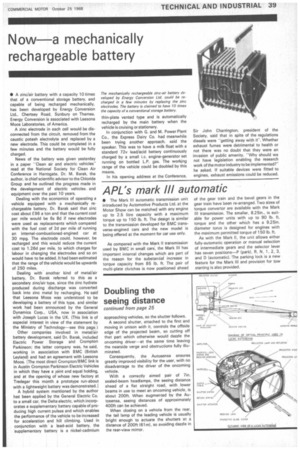Doubling the seeing distance
Page 27

Page 41

If you've noticed an error in this article please click here to report it so we can fix it.
• An entirely new vehicle lighting device of considerable importance, said to be the first of its kind in the world, has been developed by Joseph Lucas Ltd. It is designed to augment the lower headlamp (dipped) beams and will automatically adjust to suit traffic conditions: extra light, which doubles the seeing distance, is made available when driving on dipped headlights but an oncoming driver is not dazzled as the beam direction is deflected by his own headlights.
Known as the Lucas Autosensa automatic projector, the unit has been designed to match increasing vehicle performance and greater traffic density. Lucas considers that in present-day traffic conditions the seeing distances at night with existing dipped headlamps, when meeting or passing other vehicles, are not adequate. Modifications to orthodox headlamp systems can provide only marginal improvements and so a fresh approach to the problem was made.
Lucas uses an idea which has existed for many years. The amount of light emitted from the lamp is controlled by a shutter and there is an electronic system which makes the shutter position dependent on light from an oncoming vehicle. The problem was how to control the operation of such a device satisfactorily, and the solution is said to have been found only after considerable research and with the availability of semi-conductors for automotive application.
The Autosensa is essentially a light receiver and a projector unit combined in a single housing. The receiver unit comprises a receiver lens, a photo-conductive cell and lens system, and an electronic amplifier controlling a linear actuator which moves the receiveraperture shutter.
The projector unit has a quartz-halogen bulb, an ellipsoidal reflector, a projector lens and a second shutter controlling the aperture of the projected beam. Optical alignment of the receiver and projector units is achieved during the assembly and there is no possibility of maladjustment in service.
The Autosensa is normally connected for use only with the lower (dipped) beams. When the dipped beams are "on" the Autosensa projects a rectangular-patterned highintensity light beam.
As an oncoming vehicle approaches, an image of its headlamps produced in the Autosensa receiver aperture is projected on to the surface of the photo-conductive cell. An amplified signal from the photocell energizes the linear actuator which moves a shutter across the aperture, until the shutter "homes" on the image. As the image moves in the aperture with changing distance between the approaching vehicles, so the shutter follows.
A second shutter, attached to the first and moving in unison with it, controls the offside edge of the projected beam, so cutting off that part which otherwise would dazzle the oncoming driver—at the same time leaving the nearside verge and obstructions fully illuminated.
Consequently, the Autosensa ensures greatly improved visibility for the user, with no disadvantage to the driver of the oncoming vehicle.
With a correctly aimed pair of 7in, sealed-beam headlamps, the seeing distance ahead of a flat straight road, with lower beams in use to meet an oncoming vehicle, is about 200ft. When augmented by the Autosensa, seeing distances of approximately 400ft can be achieved.
When closing on a vehicle from the rear, the tail lamp of the leading vehicle is usually bright enough to actuate the shutters at a distance of 200ft (61 ml, so avoiding dazzle in the rear-view mirror.
















































































































